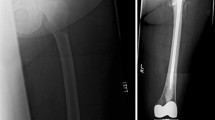Abstract
Objectives
To prospectively evaluate a novel implant, Y-STRUT® (Hyprevention, Pessac, France), designed to provide prophylactic reinforcement of the proximal femur in metastatic patients.
Methods
Ten patients presenting lytic lesions of the proximal femur were to be treated. The device consisted of two components implanted in the proximal femur, combined with bone cement. Patients were followed at 2, 6 and 12 months to record technical feasibility, safety and efficacy parameters of the procedure.
Results
All patients (62 years, 67% male) presented a pertrochanteric lesion shown on imaging with an average Mirels’ score of 9.42 (range 8–11). Procedures were performed by interventional radiologists, under general anesthesia in 97 ± 28 min, with 9.2 ± 3.1 ml of cement injected. Hospitalization duration was 2.3 ± 1.4 days. A median follow-up of 237 days (range 24–411) was reported. Wound healing was achieved in all patients, with no case of wound infection, bleeding, leakage or inflammation. Among the patients evaluated, 86% could resume walking at hospital discharge. Visual Analogue Scale decreased from 3.6 ± 2.9 before treatment to 1.3 ± 0.8 at 1 year. OHS-12 score increased from 30 ± 10 at baseline to 37 ± 6 at 1 year.
Conclusions
Results from this first-in-man study conducted in patients with metastatic bone disease show the feasibility and the safety of the intervention, with a short hospitalization, when performed following the operating instructions. Initial data showing pain-level diminution and increase in OHS-12 score indicate that both symptomatic and functional conditions of the patients were improved 1 year after the implantation of this novel implant.
Level of Evidence
Level 4, Case Series.




Similar content being viewed by others
References
Hage WD, Aboulafia AJ, Aboulafia DM. Incidence, location, and diagnostic evaluation of metastatic bone disease. Orthop Clin North Am. 2000;31(4):515–28.
Schneiderbauer MM, von Knoch M, Schleck CD, Harmsen WS, Sim FH, Scully SP. Patient survival after hip arthroplasty for metastatic disease of the hip. J Bone Joint Surg Am Vol. 2004;86(A(8)):1684–9.
Parker MJ, Khan AZ, Rowlands TK. Survival after pathological fractures of the proximal femur. Hip Int: J Clin Exp Res Hip Pathol Ther. 2011;21(5):526–30.
Deschamps F, Farouil G, Hakime A, Teriitehau C, Barah A, de Baere T. Percutaneous stabilization of impending pathological fracture of the proximal femur. Cardiovasc Intervent Radiol. 2012;35(6):1428–32.
Deschamps F, de Baere T, Hakime A, Pearson E, Farouil G, Teriitehau C et al. Percutaneous osteosynthesis in the pelvis in cancer patients. Eur Radiol. 2016;26(6):1631–9.
Ristevski B, Jenkinson RJ, Stephen DJG, Finkelstein J, Schemitsch EH, McKee MD, et al. Mortality and complications following stabilization of femoral metastatic lesions: a population-based study of regional variation and outcome. Can J Surg. 2009;52(4):302–8.
Tian Q-H, He C-J, Wu C-G, Li Y-D, Gu Y-F, Wang T et al. Comparison of percutaneous cementoplasty with and without interventional internal fixation for impending malignant pathological fracture of the proximal femur. Cardiovasc Intervent Radiol. 2016;39(1):81–9.
Arvinius C, Parra JLC, Mateo LS, Maroto RG, Borrego AF, Stern LL-D. Benefits of early intramedullary nailing in femoral metastases. Int Orthop. 2014;38(1):129–32.
Kelekis A, Filippiadis D, Anselmetti G, Brountzos E, Mavrogenis A, Papagelopoulos P, et al. Percutaneous augmented peripheral osteoplasty in long bones of oncologic patients for pain reduction and prevention of impeding pathologic fracture: the rebar concept. Cardiovasc Intervent Radiol. 2016;39(1):90–6.
Szpalski M, Gunzburg R, Aebi M, Delimoge C, Graf N, Eberle S, et al. A new approach to prevent contralateral hip fracture: evaluation of the effectiveness of a fracture preventing implant. Clin Biomech. 2015;30(7):713–9.
Ferrari S, Reginster J-Y, Brandi ML, Kanis JA, Devogelaer J-P, Kaufman J-M, et al. Unmet needs and current and future approaches for osteoporotic patients at high risk of hip fracture. Arch Osteoporos. 2016;11(1):37.
Mirels H. Metastatic disease in long bones. A proposed scoring system for diagnosing impending pathologic fractures. Clin Orthop Relat Res. 1989;249:256–64.
Jawad MU, Scully SP. In brief: classifications in brief: mirels’ classification: metastatic disease in long bones and impending pathologic fracture. Clin Orthop Relat Res®. 2010;468(10):2825-2827.
Oken MM, Creech RH, Tormey DC, Horton J, Davis TE, McFadden ET, et al. Toxicity and response criteria of the Eastern Cooperative Oncology Group. Am J Clin Oncol. 1982;5(6):649–55.
Saklad M. Grading of patients for surgical procedures. Anesthesiology. 1941;2(3):281–4.
Dawson J, Fitzpatrick R, Carr A, Murray D. Questionnaire on the perceptions of patients about total hip replacement. J Bone Joint Surg Br Vol. 1996;78(2):185–90.
Acknowledgements
None.
Funding
This study was funded by Hyprevention, Pessac, France.
Author information
Authors and Affiliations
Corresponding author
Ethics declarations
Conflict of interest
Laëtitia Rodrigues and Charlène Maas are employees of Hyprevention, Pessac, France. Vincent Cabane (Tree House Consulting, Paris, France) is a consultant for Hyprevention, Pessac, France. François Cornelis and Frédéric Deschamps are members of the scientific board of Hyprevention, Pessac, France. Thibault Carteret, Thierry De Baere, Bruno Lapuyade and Lambros Tselikas declare that they have no conflict of interest.
Human and Animal Rights
All procedures performed in studies involving human participants were in accordance with the ethical standards of the institutional and/or national research committee and with the 1964 Helsinki Declaration and its later amendments or comparable ethical standards.
Informed Consent
Informed consent was obtained from all individual participants included in the study.
Rights and permissions
About this article
Cite this article
Cornelis, F.H., Tselikas, L., Carteret, T. et al. A Novel Implant for the Prophylactic Treatment of Impending Pathological Fractures of the Proximal Femur: Results from a Prospective, First-in-Man Study. Cardiovasc Intervent Radiol 40, 1070–1076 (2017). https://doi.org/10.1007/s00270-017-1613-5
Received:
Accepted:
Published:
Issue Date:
DOI: https://doi.org/10.1007/s00270-017-1613-5




